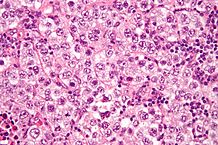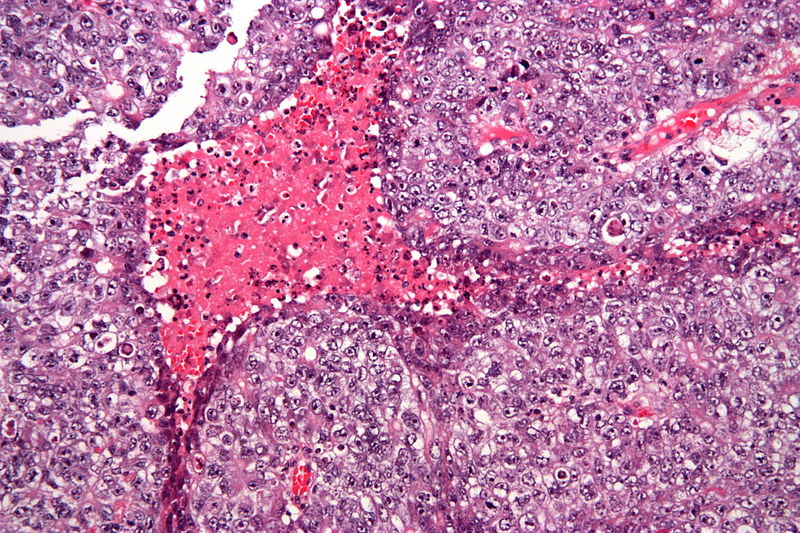Ovarian germ cell tumor pathophysiology: Difference between revisions
| Line 13: | Line 13: | ||
OR | OR | ||
*It is understood that ovarian germ cell tumors are the result of the pathologic transformation of primordial germ cells during different stages of the development.<ref name="El-MaarriRijlaarsdam2015">{{cite journal|last1=El-Maarri|first1=Osman|last2=Rijlaarsdam|first2=Martin A.|last3=Tax|first3=David M. J.|last4=Gillis|first4=Ad J. M.|last5=Dorssers|first5=Lambert C. J.|last6=Koestler|first6=Devin C.|last7=de Ridder|first7=Jeroen|last8=Looijenga|first8=Leendert H. J.|title=Genome Wide DNA Methylation Profiles Provide Clues to the Origin and Pathogenesis of Germ Cell Tumors|journal=PLOS ONE|volume=10|issue=4|year=2015|pages=e0122146|issn=1932-6203|doi=10.1371/journal.pone.0122146}}</ref> | *It is understood that ovarian germ cell tumors are the result of the pathologic transformation of primordial germ cells during different stages of the development.<ref name="El-MaarriRijlaarsdam2015">{{cite journal|last1=El-Maarri|first1=Osman|last2=Rijlaarsdam|first2=Martin A.|last3=Tax|first3=David M. J.|last4=Gillis|first4=Ad J. M.|last5=Dorssers|first5=Lambert C. J.|last6=Koestler|first6=Devin C.|last7=de Ridder|first7=Jeroen|last8=Looijenga|first8=Leendert H. J.|title=Genome Wide DNA Methylation Profiles Provide Clues to the Origin and Pathogenesis of Germ Cell Tumors|journal=PLOS ONE|volume=10|issue=4|year=2015|pages=e0122146|issn=1932-6203|doi=10.1371/journal.pone.0122146}}</ref> | ||
===Mature teratoma=== | |||
*Mature teratomas are benign tumors originating from pathologic development of primordial germ cells.<ref name="VuralVural2015">{{cite journal|last1=Vural|first1=F.|last2=Vural|first2=B.|last3=Paksoy|first3=N.|title=Vaginal teratoma: A case report and review of the literature|journal=Journal of Obstetrics and Gynaecology|volume=35|issue=7|year=2015|pages=757–758|issn=0144-3615|doi=10.3109/01443615.2015.1004525}}</ref> | |||
*These tumors contain the well-differentiated component of three germ layers. | |||
*Their usual location is the embryonic fusion line over head and neck, mediastinum,a and pre sacral area and tend to present at greater extent in midline. | |||
*[Disease or malignancy name] arises from [cell name]s, which are [cell type] cells that are normally involved in [function of cells]. | *[Disease or malignancy name] arises from [cell name]s, which are [cell type] cells that are normally involved in [function of cells]. | ||
*The progression to [disease name] usually involves the [molecular pathway]. | *The progression to [disease name] usually involves the [molecular pathway]. | ||
Revision as of 16:32, 26 February 2019
|
Ovarian germ cell tumor Microchapters |
|
Diagnosis |
|---|
|
Treatment |
|
Case Studies |
|
Ovarian germ cell tumor pathophysiology On the Web |
|
American Roentgen Ray Society Images of Ovarian germ cell tumor pathophysiology |
|
Risk calculators and risk factors for Ovarian germ cell tumor pathophysiology |
Editor-In-Chief: C. Michael Gibson, M.S., M.D. [1]; Associate Editor(s)-in-Chief: Sahar Memar Montazerin, M.D.[2]
Overveiw
The pathophysiology of ovarian germ cell tumors depends on the histological subtype. However, their origin is the primordial germ cells that transformed pathologically in different stages of development.
Pathophysiology
Physiology
The normal physiology of [name of process] can be understood as follows:
Pathogenesis
- The exact pathogenesis of or is not completely understood.
OR
- It is understood that ovarian germ cell tumors are the result of the pathologic transformation of primordial germ cells during different stages of the development.[1]
Mature teratoma
- Mature teratomas are benign tumors originating from pathologic development of primordial germ cells.[2]
- These tumors contain the well-differentiated component of three germ layers.
- Their usual location is the embryonic fusion line over head and neck, mediastinum,a and pre sacral area and tend to present at greater extent in midline.
- [Disease or malignancy name] arises from [cell name]s, which are [cell type] cells that are normally involved in [function of cells].
- The progression to [disease name] usually involves the [molecular pathway].
- The pathophysiology of [disease/malignancy] depends on the histological subtype.
Genetics
[Disease name] is transmitted in [mode of genetic transmission] pattern.
OR
Genes involved in the pathogenesis of [disease name] include:
- [Gene1]
- [Gene2]
- [Gene3]
OR
The development of [disease name] is the result of multiple genetic mutations such as:
- [Mutation 1]
- [Mutation 2]
- [Mutation 3]
Associated Conditions
Conditions associated with [disease name] include:
- [Condition 1]
- [Condition 2]
- [Condition 3]
Gross Pathology
On gross pathology, [feature1], [feature2], and [feature3] are characteristic findings of [disease name].
Gross Pathology
- The majority of mature teratomas are 5 to 10 cm in diameter.[3]
| Ovarian germ cell tumor subtype | Features on Gross Pathology |
| Dysgerminoma |
|
| Endodermal sinus tumor or yolk sac tumors |
|
| Embryonal Carcinoma |
|
| Teratoma |
Teratoma-mature
Teratoma-immature
|
Microscopic Pathology
| Ovarian germ cell tumor subtype | Features on Histopathological Microscopic Analysis | Image |
| Dysgerminomas |
|
 |
| Endodermal sinus tumor or yolk sac tumors |
|

|
| Embryonal carcinoma |
Main features:[6]
Additional features that are often mixed:
|
 |
| Teratoma |
Mature teratoma
Immature teratoma
|
 |
Microscopic Pathology
On microscopic histopathological analysis, [feature1], [feature2], and [feature3] are characteristic findings of [disease name].
References
- ↑ El-Maarri, Osman; Rijlaarsdam, Martin A.; Tax, David M. J.; Gillis, Ad J. M.; Dorssers, Lambert C. J.; Koestler, Devin C.; de Ridder, Jeroen; Looijenga, Leendert H. J. (2015). "Genome Wide DNA Methylation Profiles Provide Clues to the Origin and Pathogenesis of Germ Cell Tumors". PLOS ONE. 10 (4): e0122146. doi:10.1371/journal.pone.0122146. ISSN 1932-6203.
- ↑ Vural, F.; Vural, B.; Paksoy, N. (2015). "Vaginal teratoma: A case report and review of the literature". Journal of Obstetrics and Gynaecology. 35 (7): 757–758. doi:10.3109/01443615.2015.1004525. ISSN 0144-3615.
- ↑ Yayla Abide, Çiğdem; Bostancı Ergen, Evrim (2018). "Retrospective analysis of mature cystic teratomas in a single center and review of the literature". Journal of Turkish Society of Obstetric and Gynecology. 15 (2): 95–98. doi:10.4274/tjod.86244. ISSN 1307-699X.
- ↑ 4.0 4.1 Dysgerminoma. https://en.wikipedia.org/wiki/Dysgerminoma. URL Accessed on November 12, 2015
- ↑ Ovary tumor Germ cell tumors Yolk sac tumor. http://www.pathologyoutlines.com/topic/ovarytumoryolksac.html. URL Accessed on November 12, 2015
- ↑ 6.0 6.1 Abbas, Fausto, Mitchell (2010). Basic Pathology. Elsevier. pp. 696–697. ISBN 978-81-312-1036-9.
- ↑ Ovary tumor Germ cell tumors Teratoma-maturehttp://www.pathologyoutlines.com/topic/ovarytumorteratomamature.html. URL Accessed on November 12, 2015
- ↑ Ovary tumor Germ cell tumors Teratoma-immature. http://www.pathologyoutlines.com/topic/ovarytumorteratomaimmature.html. URL Accessed on November 12, 2015
- ↑ Endodermal sinus tumor. https://en.wikipedia.org/wiki/Endodermal_sinus_tumor. URL Accessed on November 12, 2015
- ↑ Mature teratoma. http://librepathology.org/wiki/index.php/Teratoma#Mature_teratoma. URL Accessed on November 12, 2015
- ↑ Immature teratoma. http://librepathology.org/wiki/index.php/Teratoma#Mature_teratoma. URL Accessed on November 12, 2015